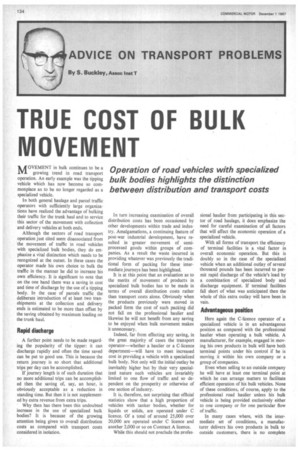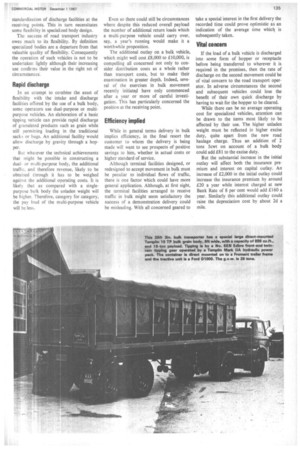TRUE COST OF BULK MOVEMENT
Page 136

Page 137

If you've noticed an error in this article please click here to report it so we can fix it.
Operation of road vehicles with specialized bulk bodies highlights the distinction between distribution and transport costs
MOVEMENT in bulk continues to be a growing trend in road transport operation. An early example was the tipping vehicle which has now become so commonplace as to be no longer regarded as a specialized vehicle.
In both general haulage and parcel traffic operators with sufficiently large organizations have realized the advantage of bulking their traffic for the trunk haul and to service this sector of the movement with collection and delivery vehicles at both ends.
Although the sectors of road transport operation just cited seem disassociated from the movement of traffic in road vehicles with specialized bulk bodies, they do emphasize a vital distinction which needs to be recognized at the outset. In these cases the operator made his own choice to bulk the traffic in the manner he did to increase his own efficiency. It is significant to note that on the one hand there was a saving in cost and time of discharge by the use of a tipping body. In the case of parcels traffic the deliberate introduction of at least two transhipments at the collection and delivery ends is estimated to be more than offset by the saving obtained by maximum loading on the trunk haul.
Rapid discharge
A further point needs to be made regarding the popularity of the tipper: it can discharge rapidly and often the time saved can be put to good use. This is because the return journey is so short that additional trips per day can be accomplished.
If journey length is of such duration that no more additional trips can be accomplished then the saving of, say, an hour, is obviously acceptable as a reduction in standing time. But then it is not supplemented by extra revenue from extra trips.
Why then has there been this undoubted increase in the use of specialized bulk bodies? It is because of the growing attention being given to overall distribution costs as compared with transport costs considered in isolation. In turn increasing examination of overall distribution costs has been occasioned by other developments within trade and industry. Amalgamations, a continuing feature of post-war industrial development, have resulted in greater movement of semiprocessed goods within groups of companies. As a result the waste incurred in providing whatever was previously the traditional form of packing for these intermediate journeys has been highlighted.
It is at this point that an evaluation as to the merits of movement of products in specialized bulk bodies has to be made in terms of overall distribution costs rather than transport costs alone. Obviously when the products previously were moved in packed form the cost of such packing did not fall on the professional haulier and likewise he will not benefit from any saving to be enjoyed when bulk movement makes it unnecessary.
Indeed, far from effecting any saving, in the great majority of cases the transport operator—whether a haulier or a C-licence department—will have to meet increased cost in providing a vehicle with a specialized bulk body. Not only will the initial outlay be inevitably higher but by their very specialized nature such vehicles are invariably limited to one flow of traffic and so dependent on the prosperity or otherwise of one section of industry.
It is, therefore, not surprising that official statistics show that a high proportion of vehicles with tanker bodies, whether for liquids or solids, are operated under C licence. Of a total of around 25,000 over 20,000 are operated under C licence and another 2,000 or so on Contract A licence.
While this should not preclude the profes
sional haulier from participating in this sector of road haulage, it does emphasize the need for careful examination of all factors that will affect the economic operation of a specialized vehicle.
With all forms of transport the efficiency of terminal facilities is a vital factor in overall economic operation. But this is doubly so in the case of the specialized vehicle when an additional outlay of several thousand pounds has been incurred to permit rapid discharge of the vehicle's load by a combination of specialized body and discharge equipment. If terminal facilities fall short of what was anticipated then the whole of this extra outlay will have been in vain.
Advantageous position
Here again the C-licence operator of a specialized vehicle is in an advantageous position as compared with the professional haulier when operating a bulk vehicle. A manufacturer, for example, engaged in moving his own products in bulk will have both terminal points under his control if he is moving it within his own company or a group of companies.
Even when selling to an outside company he will have at least one terminal point at which he can arrange matters to facilitate efficient operation of his bulk vehicles. None of these conditions, of course, apply to the professional road haulier unless his bulk vehicle is being provided exclusively either to one company or for one particular flow of traffic.
In many cases where, with the intermediate set of conditions, a manufacturer delivers his own products in bulk to outside customers, there is no complete standardization of discharge facilities at the receiving points. This in turn necessitates some flexibility in specialized body design.
The success of road transport industry owes much to its flexibility. By definition specialized bodies are a departure from that valuable quality of flexibility. Consequently the operation of such vehicles is not to be undertaken lightly although their increasing use confirms their value in the right set of circumstances
Rapid discharge
In an attempt to combine the asset of flexibility with the intake and discharge facilities offered by the use of a bulk body, some operators use dual-purpose or multipurpose vehicles. An elaboration of a basic tipping vehicle can provide rapid discharge of granulated products such as grain while still permitting loading in the traditional sacks or bags. An additional facility would allow discharge by gravity through a hopper.
But whatever the technical achievements that might be possible in constructing a dualor multi-purpose body, the additional traffic, and therefore revenue, likely to be obtained through it has to be weighed against the additional operating costs. It is likely that as compared with a singlepurpose bulk body the unladen weight will be higher. Therefore, category for category, the pay load of the multi-purpose vehicle will be less. Even so there could still be circumstances where despite this reduced overall payload the number of additional return loads which a multi-purpose vehicle could carry over, say, a year's running would make it a worthwhile proposition.
The additional outlay on a bulk vehicle, which might well cost £8,000 to £10,000, is compelling all concerned not only to consider distribution costs as a whole rather than transport costs, but to make their examination in greater depth. Indeed, several of the exercises in bulk movement recently initiateçl have only commenced after a year or more of careful investigation. This has particularly concerned the position at the receiving point.
Efficiency implied
While in general terms delivery in bulk implies efficiency, in the final resort the customer to whom the delivery is being made will want to see prospects of positive savings to him, whether in actual costs or higher standard of service.
Although terminal facilities designed, or redesigned to accept movement in bulk must be peculiar to individual flows of traffic, there is one factor which could have more general application. Although, at first sight, the terminal facilities arranged to receive traffic in bulk might seem satisfactory the success of a demonstration delivery could be misleading. With all concerned geared to take a special interest in the first delivery the recorded time could prove optimistic as an indication of the average time which is subsequently taken.
Vital concern
If the load of a bulk vehicle is discharged into some form of hopper or receptacle before being transferred to wherever it is required in the premises, then the rate of discharge on the second movement could be of vital concern to the road transport operator. In adverse circumstances the second and subsequent vehicles could lose the benefit of their own quick discharge by having to wait for the hopper to be cleared.
While there can be no average operating cost for specialized vehicles, attention can be drawn to the items most likely to be affected by their use. The higher unladen weight must be reflected in higher excise duty, quite apart from the new road haulage charge. Thus an addition of 2 tons 5cwt on account of a bulk body could add £81 to the excise duty.
But the substantial increase in the initial outlay will affect both the insurance premium and interest on capital outlay. An increase of £2,000 in the initial outlay could increase the insurance premium by around £20 a year while interest charged at new Bank Rate of 8 per cent would add £160 a year. Similarly this additional outlay could raise the depreciation cost by about 2d a mile.




























































































































































































